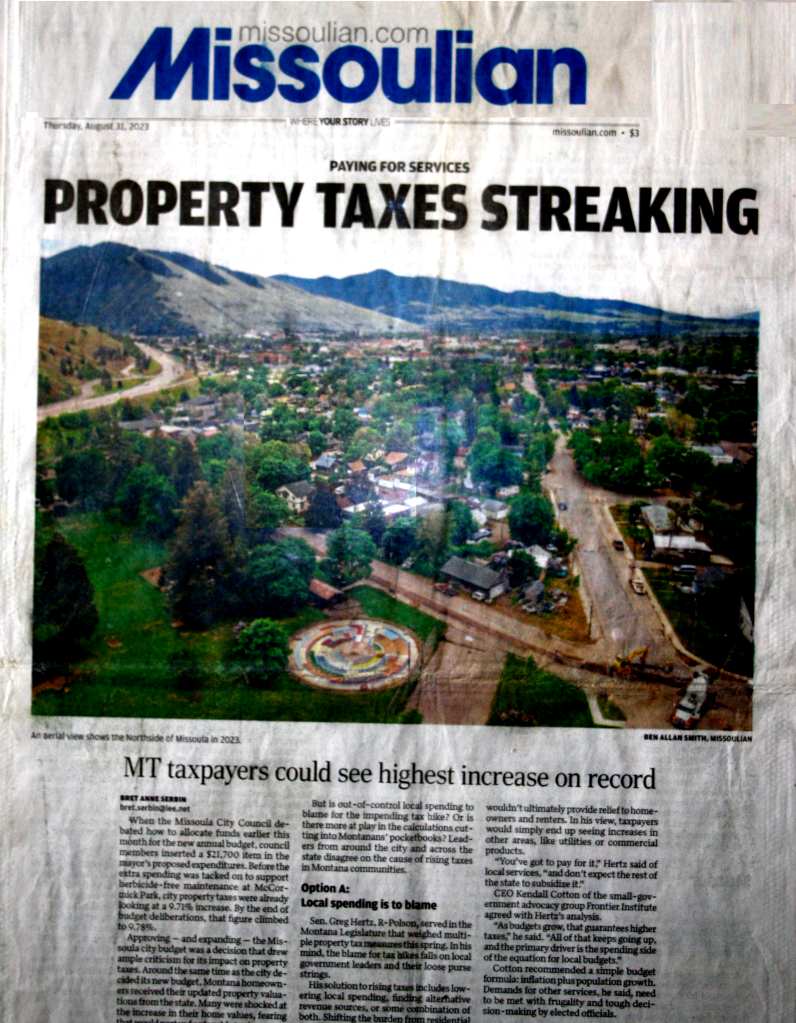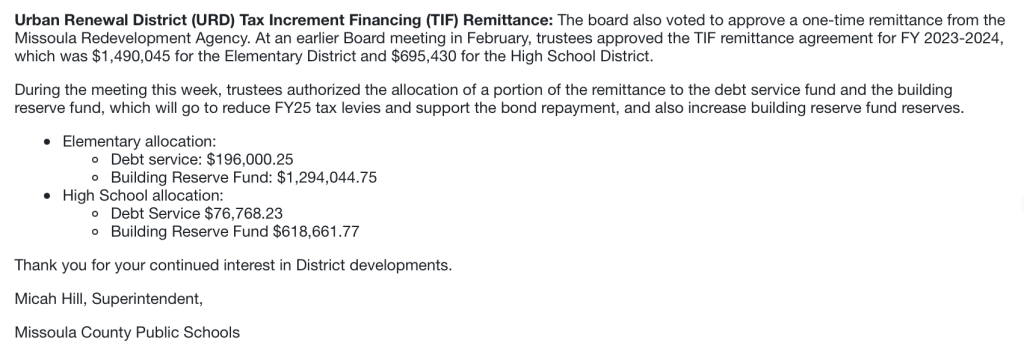Who benefits from rising property taxes? Why does Missoula need another special tax levy to keep the firefighters in business when property taxes are already sky high as it is? And why are the lords of Missoula’s budget exempt from the election process?
As Missoulians reluctantly brace for the imminent effects of last year’s 37% property assessment increase (and subsequent 21% property tax increase) a major share of the fault lies with the unorthodox drain on municipal budgets that’s always justified through the ever-profitable concept of redevelopment. An unelected body of members loyal to the Missoula Redevelopment Agency (MRA) now ultimately decides where Missoula’s tax money goes and how it’s divvied out. More often than not large quantities of our tax money gets skimmed and funneled to crony donors instead of where it should be going: schools, roads and municipal services.
Missoula locals are constantly forced to accept special tax levies to sustain services we’re already paying for because the general fund never seems to have any money in it. Taxpayers cannot reverse this trend through voting because none of the bureaucrats responsible for these tax abuses were ever elected by voters. By dominating the management of Missoula’s tax dollars and what those dollars pay for, the MRA consistently proves that it has more power than any elected figurehead. Mayors come and go but the permanent bureaucracy of the MRA maintains a uniform continuity of governance, and they do it with something called Tax Increment Financing (TIF).
The stated and primary purpose of TIF is “to increase taxable value,” which is great for banks, developers and bureaucrats who profit from the plight of workers and retirees. For property owners, increasing the taxable value of their homes means paying higher property taxes, but without any kind of corresponding increase in government services. For renters that means increased rents. For the countless workers who cannot magically double their income overnight, such increases signal their imminent displacement. This game of musical chairs leaves someone without a place to live at the end of every round and only the biggest bank accounts can prevail.
Naturally, the intractable parasites who’ve grown addicted to tax money have a deep-seated fear of public awareness. Runaway redevelopment agencies all too often rely on public ignorance of the law to abuse it to the extent that they have, and make claims of public benefit that are demonstrably false to cover their tracks. After Missoula officials publicly mocked their constituents in 2020 for our alleged ignorance of TIF, Fortune 500 CFO Bob Moore publicly declared to the City Council:
“I understand [TIF] very well. It’s nothing but taking taxpayer money and giving it to developers and builders and calling it investment.”
TIF bonds are so coveted and controversial that those who consistently profit from them expend great deals of energy and resources attempting to convince the public that our lives would collectively fall apart without them. But beyond the hypothetical promises of “free money” and healthier cities, TIF turns out to be just another insidious profiteering scheme that feeds off of public money. This mechanism remains shrouded by acronym and is cleverly designed to smokescreen reality behind complicated financial terminology that ensures most people will never bother figuring out what makes it tick, including legislators and policy makers.
Over the decades the TIF law has morphed from a pledge to eliminate urban blight into the duct-tape solution for every municipal pipe dream. Since their inception half a century ago, urban renewal agencies around the country have often abused their authority and consistently transformed TIF into a mechanism to rob struggling taxpayers in order to provide giant subsidies to large organizations and fund the pet projects of favored donors. Whatever its original intentions, TIF has proven as vulnerable to nefarious activity in the Treasure State as it has in many others.
The word “blight” as defined in the Montana State code allows for any and every possible interpretation, including wildly imaginative perversions like “future blight” and several shades of figurative blight. The law as currently written is rife with loophole opportunities, allowing TIF addicts to interpret whatever definition of blight they want while also technically operating within the letter of the law. As a result, local officials bend themselves into pretzels figuring out as many new ways as possible to spend taxpayer dollars on anything but what they’re intended for: schools, roads and municipal services!
To “improve” these so-called “blighted” areas, TIF-addicted governments accept debt from banks to catalyze solutions. That debt is supposedly paid off with revenue generated by new residents and businesses that benefit from the blight remediation. Since TIFs theoretically pay for themselves by raising the property values of surrounding areas, those adjacent properties are directly affected by the newly elevated values because they create higher tax burdens. Therefore, TIF is meant to increase taxable value of property, and this hurts local citizens and fixed-income taxpayers. Worse still, since many TIF subsidies are provided to out-of-state corporations, local businesses are forced to stand idly by as their tax dollars are literally weaponized against them, economically prioritizing the interests of outside competition. Short-term gains leave long-term residents holding the shit-end of the stick.
Officials who’ve grown dependent on TIF will insist it’s the only tool they have. They’ll say they need it to subsidize affordable housing, to provide incentives for business developments and real estate investment, for job creation, to assist nonprofits, and to grow the tax base. But former Montana Legislator (and former Missoula City Councilman) Adam Hertz asserts that TIF isn’t meant to pay for any of that:
“Those are all great things. None of them are mentioned in state law when it comes to urban renewal districts.”
Despite what tax addicts may claim, the TIF statute says nothing about economic development, job creation or housing. It’s for blight remediation, not a blank check for vertical development.
If the only tool you have is a hammer, every problem tends to look like a nail. After years of increasingly misusing and abusing the TIF hammer, Missoula began attracting criticism from a former MRA director. Geoff Badenoch, who directed the Missoula Redevelopment Agency for the 18 years before the reign of Ellen Buchanan, had this to say about Missoula’s dependence on and addiction to TIF:
“If you find there’s a temptation to use a tool too often, you’re not a good craftsman. … The thing about tax increment is, it’s so tempting to use it because you don’t have to go to the voters for it. There’s millions lying around.”
One of the core problems with TIF in modern Montana lies with the fact that public money is spent against popular will by an unelected body. The most powerful bureaucrats in our governments are never vetted by voters, but appointed to their positions, sometimes for decades. Ellen Buchanan is working on her third consecutive decade as chief meddler in Missoula’s piggy bank, and there’s nothing that voters can do about it.
Windbag politicians flap their jaws advocating for things like workforce housing, zoning reform, increased subsidies, housing-choice vouchers and trickle-down rent relief to address the symptom of rising homelessness because those “solutions” favor the status quo while ignoring the real problems. Those same windbags then help parasitic redevelopment agencies hollow out the city’s general fund on unnecessary and irrelevant “improvement” projects. As a result, firefighters must now beg taxpayers to approve special levies that further drive taxes up for people who can barely afford them, which pushes even more people toward displacement. As former Montana legislator Brad Tschida explicates in his recent Missoulian op-ed:
“[…] if the liberal Dem mayor and city councilors were frugal stewards of the tax dollars we’ve already sent them, there would currently be plenty of money to adequately fund our firefighters.”
The stuffed shirts calling the shots in Missoula’s secret government all too often treat their municipalities like a sadistic game of Sim City 2000 or CityState. Myopic officials relentlessly propound their failed solutions because they’ve run out of excuses to accrue more TIF debt. As the dumpster fire grows we’re told that dousing it with more gasoline will help extinguish the flames.
TIF was the mechanism through which Missoula’s unelected officials borrowed millions of dollars from banks to provide giant gifts to those same banks. Decades worth of taxpayer-funded interest payments were provided to First Interstate Bank and Stockman Bank by borrowing said gifts from the same banks and packaging those gifts in the wrapping paper of Tax Increment Financing. The taxpayers get stuck with decades of unwelcome interest payments instead of the municipal services they expect from government. In fact, those services steadily deteriorate to the point that extra taxes are proposed, euphemistically referred to as “levies”. Case in point, Missoula’s firefighter levy would not be a topic of conversation if the City’s handling of the budget weren’t so flagrantly corrupt.
Officials addicted to tax increment loans have cultivated relationships with the financial industry to the point that they don’t know how to operate their towns without the banks. In a rare case of pissing-on-our-leg-and-telling-us-it’s-raining, we’re told that without TIF there just aren’t any resources for governments to fix the roads. This irrational claim was actually made by MRA director Ellen Buchanan in 2023:
“Without TIF investment in public facilities, roads, bridges, parks, other infrastructure, this puts more pressure on local governments to find ways to pay for these services.”
Buchanan strategically frames the argument from a brazenly dishonest perspective, presuming that scheduled maintenance cannot occur without accruing debt. But we don’t need a bank loan to fix the roads if our tax dollars are handled honestly. Property taxes are collected into the general fund but the account always seems to have insufficient funds to pay for services when the check comes due. Beyond that, municipal services now receive their funding directly from the redevelopment agency. The very idea of redevelopment seems to have become deliberately conflated with the concepts of maintenance and management to the point that many officials have forgotten how to fund services without the MRA.
Missoula County Public Schools admitted to an unconventional funding gift from the Missoula Redevelopment Agency in an Email last month. According to the employee newsletter, the MRA provided $2 million in funding to the school district in the form of a “remittance”. Because the MRA seems to enjoy exclusive control over the city budget, the only way to get a slice of that budget is to cozy up to MRA director Ellen Buchanan.
The fact that a redevelopment agency now funds schools through a nebulous “remittance” process seems outrageous. Why exactly is the school district receiving funding through the MRA instead of directly from the general fund? The MRA was supposed to only deal with issues pertaining to redevelopment, not the maintenance or staffing of every local government body.
Who benefits when scores of locals are displaced by skyrocketing rent increases? It is not possible to pull yourself up by your bootstraps when the free-money cult of tax addicts keeps taking your boots away. The inevitable corruption of the scheme itself demonstrates its irredeemable nature. We can explore the theoretical benefits of this economic voodoo until the cows come home, but the rhetoric that justifies TIF spending is simply never backed up by facts.
Public money addicts actively ignore the overwhelming impacts that their policies inflict on average citizens. They can be expected to further minimize the disproportionate burden placed on Montana taxpayers caused by their overindulgence on this financial instrument. To acknowledge such “side effects” would interrupt the rush of their high. Reality is a buzzkill for addicts forced to come to terms with the harm their actions cause. The MRA desperately needs an intervention before they sell Missoula’s proverbial kitchen sink to score another hit.
Thorough analysis of the literature generated by regulatory professionals who’ve attempted to curtail TIF abuse with amendments to existing law makes it clear that the abuse continues regardless of what kind of new regulations are put into place. The fanatics who feel they’re entitled to the subsidy don’t ever take “no” for an answer and never will. Whenever the will of the voters becomes bad for business, the industry’s lawyers weave a tapestry of new loopholes to continue spending public money without voter knowledge or consent.
The parasites who’ve turned the government budget into their own personal piggy bank will also predictably point their hypocritical little fingers at “the evil Republicans” at the State Capital as the reason for rising property taxes, no matter how obvious it is that more and more of the municipal tax base has been “captured” and re-routed to subsidize the private development delusions of transplants.
TIF addicts will often and loudly mention that TIF is practiced by a majority of the states, but probably won’t mention that it was killed in the very state in which it was created. TIF was born in California and died in California after bankrupting the Golden State. But California isn’t the only state with a robust record of abusing TIF, nor is California the only state to attempt to curtail TIF abuse.
Montana’s first real attempt to reign in the abuse during the 2023 legislative session revealed the primary tactic of the TIF addicts, who relied on scaring the legislators with fibs about how the sky will fall without these subsidies to hold it up. It’s a simplistic deception, but it has always been easier to fool a man than to convince him that he’s been fooled, and the lie succeeded in shutting down the regulations proposed by Senator Greg Hertz.
As this nightmare carousel of circular logic revolves into another election season, let’s consider how much longer we’re willing to passively accept the anti-human outcomes scripted for us by society’s ruling psychopaths.











